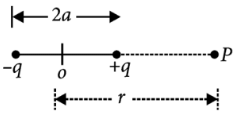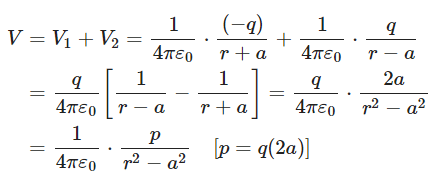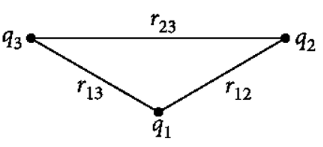NEET Exam > NEET Notes > Physics Class 12 > Important Derivations: Electrostatic Potential and Capacitance
Important Derivations: Electrostatic Potential and Capacitance | Physics Class 12 - NEET PDF Download
Derivations Related to Potential due to an Electric Dipole
Derivation 1: Electric potential due to electric dipole at a point on its axial line.
Sol: Let ‘P’ be an axial point at distance ‘r’ from the centre of the dipole. Electric potential at point P will be
Let ‘P’ be an axial point at distance ‘r’ from the centre of the dipole. Electric potential at point P will be For a far away point, r>>a
For a far away point, r>>a Thus, due to a dipole potential at a point is
Thus, due to a dipole potential at a point is
Derivations Related to Potential Energy of System of Charges
Derivation 2: Expression for electric potential energy of a system of three charges
Sol: 
To bring q1 from infinity to  , no work is required. Work done is bringing charge q2 from infinity to
, no work is required. Work done is bringing charge q2 from infinity to  is
is

The charges q1 and q2 produce a potential, which at any point p is given by
 Work done next in bringing q3 from infinity to the point
Work done next in bringing q3 from infinity to the point  is
is
The total work done in assembling the charges at the given location is obtained by adding the work done in steps (i) and (ii) is

The document Important Derivations: Electrostatic Potential and Capacitance | Physics Class 12 - NEET is a part of the NEET Course Physics Class 12.
All you need of NEET at this link: NEET
|
74 videos|314 docs|88 tests
|
FAQs on Important Derivations: Electrostatic Potential and Capacitance - Physics Class 12 - NEET
| 1. What is the electric potential due to an electric dipole? |  |
Ans. The electric potential due to an electric dipole at a point in space is given by the equation V = k * p * cosθ / r^2, where V is the electric potential, k is the electrostatic constant, p is the magnitude of the dipole moment, θ is the angle between the dipole moment and the line connecting the point to the dipole, and r is the distance between the point and the dipole.
| 2. How can the potential energy of a system of charges be calculated? |  |
Ans. The potential energy of a system of charges can be calculated by using the equation U = k * q1 * q2 / r, where U is the potential energy, k is the electrostatic constant, q1 and q2 are the magnitudes of the charges, and r is the distance between the charges.
| 3. What are some important derivations related to electrostatic potential and capacitance? |  |
Ans. Some important derivations related to electrostatic potential and capacitance include the derivation of the formula for the electric potential due to a point charge, the derivation of the formula for the electric potential due to an electric dipole, the derivation of the formula for the electric potential due to a uniformly charged spherical shell, and the derivation of the formula for the capacitance of a parallel plate capacitor.
| 4. How is the electric potential due to a point charge derived? |  |
Ans. The electric potential due to a point charge can be derived by considering the work done to bring a test charge from infinity to a point in the electric field of the point charge. By integrating the work done formula, which is given by W = q * V, where W is the work done, q is the test charge, and V is the electric potential, the equation V = k * q / r can be derived, where k is the electrostatic constant and r is the distance between the point charge and the test charge.
| 5. What is the formula for the capacitance of a parallel plate capacitor? |  |
Ans. The formula for the capacitance of a parallel plate capacitor is given by C = ε * A / d, where C is the capacitance, ε is the permittivity of the material between the plates, A is the area of each plate, and d is the distance between the plates.
Related Searches
















